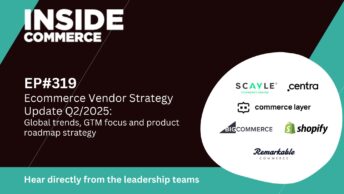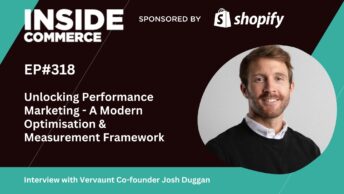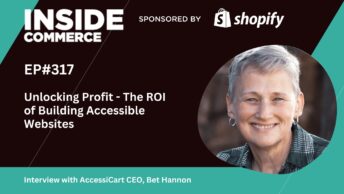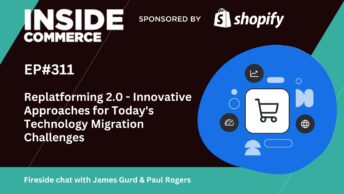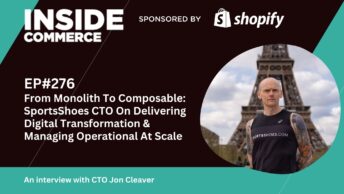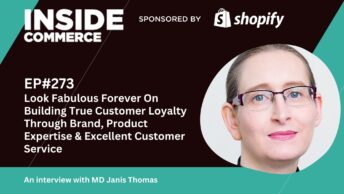In this ecommerce podcast, James and Paul discuss the biggest costs areas in a project, how you can manage them sensibly and effective ways to shave cost lines.
Listen on your favourite player
Watch the video
Tl;dr
- What are the biggest costs areas in a project and how do you manage them?
- What project efficiencies can you introduce to reduce cost lines?
- What are the nice to haves that can be cut without materially damaging your project success?
The current global and local economic outlook is as bleak as February’s winter mist. Online retail boomed during the pandemic and online traffic and sales maintained a higher than pre-pandemic level throughout 2021 but towards the second half of 2022 and into 2023 the sharp bite of increasing costs and consumer nervousness around spending bit hard.
For some businesses, capital projects are on hold. For others, the need to improve tech infrastructure to support business growth or even protect existing sales means they need to press on but with a sharper eye on budget. In this episode we look at ways businesses can sensibly manage project costs downwards without having to rip the heart out their scope and functionality.
Advice from ecommerce experts
We reached out to our network on LinkedIn for other people’s advice on cost management, here’s what they said:
“A well-planned discovery keeps cost down before you even begin a project as the likelihood of unknowns is dramatically reduced. So it is a strategic initiative to avoid increased costs in the first place. And even if a big cost is identified, the brand has the power to proceed or not AND identify the ROI on that cost before pulling the trigger.” However, I get your point. So I’d say discovery + MVP and agile or phased development are formidable forces for both controlling a budget and reducing cost ‘in build’.” Tim Richardson, Fern Studios
“Most ecommerce projects feel the stress of cost/quality/time constraints. Understanding and sharing the overlap of the relationship between these dimensions and developing realistic requirements from the outset is vital.” Andy Vanags, SheerID
“Use the MVP approach to get as fast as possible to the first release that will start delivering value to the business. Be absolutely ruthless in eliminating or deferring nice-to-have functionality. When racing towards MVP, always keep in mind the final destination, where you want to be when all is done, business goals are met, and online revenue is growing.” Michael Vax, Commercels Digital
“Do a comprehensive job gathering requirements before choosing the ecommerce platform. We often find that mature ecommerce sites have a lot of features that have evolved over time. Many of the features are not used and don’t provide much value. So, as part of the initial Discovery and Definition phases, confirm which features are “must have” requirements.” Graham Lubie, Wasserman
“Phasing the build so the cost is spread out over a longer time period, and you can sense check at each stage to make sure you’re paying for things that will actually benefit you.” Chloe Thomas, eCommerce Masterplan
“It is amazing how scope can get ruined quickly. In my humble opinion, breaking down the project into extremely tight phases (Phase 1, phase 2, etc…) brings a simple yet disciplined approach that keeps on project within scope.” Curt Anderson, B2B Tail
“B2B e-commerce should segment their customers. Top customers/A- and B-customers will continue to be served by sales staff or EDI. Start with the small customers/C-customers needs first or try to lead new customers via the digital touchpoints/websites. Maybe start with a partial range that does not need to be configured or that is re-ordered. Invest in ERP integration rather than a super-customised look and feel.” Ingo Haggeman, Projekteins
“Experiment first – a good AB test designer and developer can often have a proof of concept live in days, allowing you to learn how users really respond to an idea. In contrast an “official permanent feature” can take months of stakeholder reviews, with battling egos and agendas, followed by months of expensive development, ensuring it’s scalable, future proof etc, only to reach similar conclusions.” Dave Mullen, CRO Consultant.
“Consolidating tech is a great way to lower costs, reduce integration and have one less thing to manage.” Neil Park, Jarrold Norwich
“Having a reasonable understanding of what you’re asking entails. If the estimate is more than expected, why? Is there anything that we could change or remove that would make a difference? Having a good relationship with the devs, so they feel they can push back on the brief if they think there’s a better way of doing it.” Janis Thomas, Look Fabulous Forever
“Hire the right project manager to start with, ensure the scope is well defined and not just a wish list of requirements with no real benefit, track and monitor time usage and who is doing what.” Graham Broomfield, Neve Jewels Group
“Pay for a proper, detailed discovery – the number of enquiries we get from people that just go for it without proper planning is crazy.” Rupert Cross, 5874 Commerce
“Another approach would be to avoid spending too much time (and money) in discovering and outlining the ideal or gold star product, but rather focus your time and budget on the absolute essentials. While discovery is important, it’s easy to get into long-winded and detailed discovery that will inflate costs.” Eray Mehmet, Corra
“Follow these 3 steps in order to save a lot of pain and cost.
Step 1. Be clear before you start on your acquisition channels, integrations, and key functionality your business requires. Standard catalog/basket/checkout is a given these days but do you need subscription services, loyalty schemes, product feeds, how do your marketing agencies & ad networks expect things to be tagged and tracked etc.
Step 2. Have someone platform agnostic involved right at the start who has worked across a number of platforms and can help you to navigate the pros and cons of each & whether they are the right fit – all vendors will tell you they “can do that” but the implementation costs and TCO can be wildly different
Step 3. When you start make sure you have an experienced project manager and technical architect involved who understand the platform.” Dan Coleman, Coleman Marketing
“It’s worth mentioning that the level of internal resource/support provided to an agency from a merchant can certainly influence cost and timeframes. It’s important for an agency to understand this resource and take this into account when scoping, as it’s beneficial for everyone to utilise that talent.” Joseph Brown, Kubix
“One way to keep costs under control is to break up a project into 2 (or more) phases. And for each phase, have a ‘must have’ bucket and a ‘nice to have’ bucket with estimated costs for each of those requirements. You can then get a full view and make informed tradeoffs.” Daniel Fertig, BigCommerce
“If you buy cheap, you buy twice. Beware of agencies or independents offering to build a site for 2-3 times less than others. There’s probably a reason why. The amount of rescue builds we used to pick up was amazing. Ok it doesn’t keep the costs down initially but it stops you paying more later down the line, not to mention the time you lose by having to either start again or get another team to pick it up.” Pete Robertshaw, Space 48
“I think also working towards an MVP from the outset but with a clear idea on what future iterations would entail is also key. Adopting this sort of agile approach allows the wider business (or the holder of the purse strings) the ability to appraise outcomes, see the value (or not) then move to next phase.” Mat Brown, Universal Works
“Plan the data migration strategy BEFORE you start writing code. I’ve seen a lot of replatforms where that wasn’t looked at until too late, and it turned out the existing data structure didn’t support the nice designs, or the integrations, or the customizations. Sadness ensued.” Aaron Sheehan, BigCommerce
Discussion notes
- Build – agency
- Rip out customisation that isn’t needed for core ecommerce goals
- BI and reporting: creating custom reports for things like promotions, product sell through rate, sales & tax reporting >> this is for ERP/BI project
- OMS customisation e.g. commercial invoices
- Checkout – structure
- Recent example – SEO side of filtering on Shopify
- Recent example – multiple addresses in account
- Perfect example – global accounts
- Product bundles – use virtual to avoid ERP setup work
- Checkout – DD (vs. recurring card payment)
- Back-end processes and workflows
- Content management
- Be sensible on the number of layouts you need
- Spec each layout to be clear on functional requirements – avoids adding dev cost later when you realise it’s not what you wanted!
- How advanced do you really need? E.g. do you really need full staging, many work with live preview
- Pushing into 3rd party, we’ll cover later – work with native features, work around things like lack of workflow
- Scope control
- Ensure you’re controlling scope (avoid unnecessary items but build for future)
- Use a robust prioritization system to stop everything being ‘must have’ – e.g. do we have it already and need it? Is it fixing a known issue? Will it protect or grow revenue? Is it essential for compliance?
- This is where project steering comes in handy, even if it’s just the project owner and sponsor: consistent decision process and communicate reasons for decisions
- Manage backlog and size/estimate each item then look at business benefit vs. cost >> can push some into phase 1 if bandwidth allows
- Integrations: make the most of the platform ecosystem e.g. Shopify + POS for omnichannel to avoid 3rd party POS integration + comes free with Plus – saves license fee
- Project management
- How big/complex is the project – small team, single site, limited integrations > don’t need a dedicated FT PM
- Let SI do all the technical PM work, can use person from current team to be the day to day contact for task management
- Inbetween version is use an experienced consultant on a small retainer for oversight and control e.g. 1 day per week >> can save £40k+ on a 6 month project
- Ensure you have enough definition to avoid overages
- Be careful with T&M
- Single agency for design & build (takes DD)
- Potentially look for a partner that can also manage integrations? Assuming the approach is still fine
- Avoiding multiple SLAs for support where the sum is more than a single SLA
- Third party solutions: be realistic about how much best in class tooling you need
- What’s critical?
- Native vs third party – could you start with native search or recs, for example?
- Are there opportunities to save money by reviewing existing third parties
- Example: project wanting to put in Algolia on top of native elastic search but search was around 2% of sessions and very basic search queries – why?
- Personalisation engine: if you don’t do it already do you need it in phase 1 – push to phase 2, focus on core
- Subject matter specialist consultants and agencies
- PM – could it be done in-house? Need to be careful though
- SEO – critical
- Analytics – critical but to what extent – as in could live with native connector for GA4 then build full later?
- QA – could be done in-house?
- UAT don’t need to use 3rd party can do yourself with a structured plan
- Accessibility cost vs. value – when do you need a specialist agency?
Want to suggest a topic or guest for a future episode? Contact us via the website or on Twitter.

